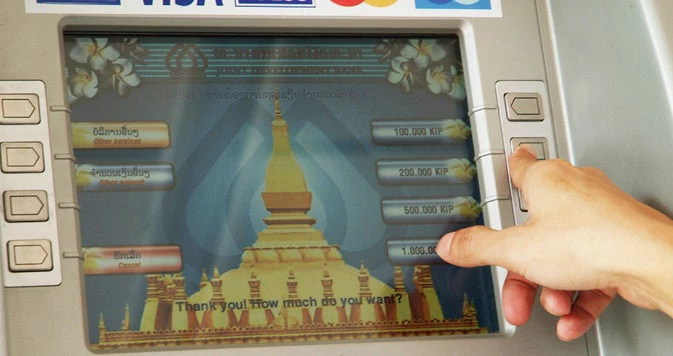Joint Development Bank's ATM, Lao PDR. IFC Photo Collection
While some 700 million people have gained access to a transaction account between 2011 and 2014, there are still about 2 billion adults in the world who lack access to transaction accounts offered by regulated and/or authorized financial service providers. The increased role that non-banks play in financial services, particularly in the payments area, has contributed to making them available and useful to many people who were previously locked out of the financial system.
There is broad recognition that financial inclusion can help people get out of poverty as it can help them better manage their finances. Access to a transaction account is the first step in that direction. A transaction account allows people to take advantage of different (electronic) ways to send or receive payments, and it can serve as a gateway to other financial products, such as credit, saving and insurance.
Payment services are usually the first and typically most often used financial service. Understanding how payment aspects can affect financial inclusion efforts is important not only for the Committee of Payments and Market Infrastructures (CPMI) of the Bank for International Settlements and the World Bank Group, but for all stakeholders with interest in increasing financial access and broader financial inclusion.
This is why we convened a task force to analyze this issue in a comprehensive manner by bringing together experts from central banks, development banks and international organizations.
As the task force, we agreed on the financial inclusion premise that all individuals and businesses should have access to and be able to use at least one transaction account operated by a regulated payment service provider to:
- Perform most, if not all, of their payment needs
- Safely store some value
- Serve as a gateway to other financial services
Recently, we published these findings in a consultative draft on Payment Aspects of Financial Inclusion, which is available for a three-month public consultation until December 7, 2015.
While the report includes a “crash-course” on the retail payments industry as a whole, it also analyzes how payment systems and services promote access to and use of financial services.
The report draws findings based on successful initiatives to increase access to and usage of transaction accounts, particularly those measures that fall within the scope of financial sector authorities and other stakeholders, including service providers and users. The report features numerous concrete measures and successful examples from around the world and we can only mention a few of them here.
- With the growth of e-money products and the aggregate value of funds stored in the underlying e-money accounts, financial authorities are paying increasing attention to the risk of misuse or loss of these customer funds, which are typically not comprised in deposit guarantee schemes. For example, India and the United States, have introduced measures to protect customer funds if the issuer of prepaid payment instruments becomes insolvent.
- The fees, terms and conditions associated with transaction account services and/or individual payment instruments can be quite complex, particularly for first-time customers. The European Union and Turkey have introduced requirements for the transparency and comparability of account fees and payment services.
- Brazil has made transaction account service points significantly more available throughout the country through agent banking/correspondents. The Central Bank of Brazil started developing the current model in the late 1990s, which has now become a permanent part of its agenda. Today, correspondent outlets exist in all of Brazil’s municipalities, and they account for more than half of all financial service access points in the country. Other countries in Latin America and the Caribbean, Russia and India are following suit.
- Commitment
Commitment from public and private sector organizations to broaden financial inclusion is explicit, strong and sustained over time. - Legal and Regulatory Framework
The legal and regulatory framework underpins financial inclusion by effectively addressing all relevant risks and by protecting consumers, while at the same time fostering innovation and competition. - Financial and ICT Infrastructures
Robust, safe, efficient and widely reachable financial and ICT infrastructures are effective for the provision of transaction accounts services, and also support the provision of broader financial services. - Transaction account and payment product design
The transaction account and payment product offerings effectively meet a broad range of transaction needs of the target population, at little or no cost. - Readily available access points
The usefulness of transaction accounts is augmented with a broad network of access points that also achieves wide geographical coverage, and by offering a variety of interoperable access channels. - Financial literacy
Individuals gain knowledge, through financial literacy efforts, of the benefits of adopting transaction accounts, how to use those accounts effectively for payment and store-of-value purposes, and how to access other financial services. - Large-volume, recurrent payment streams
Large-volume and recurrent payment streams, including remittances, are leveraged to advance financial inclusion objectives, namely by increasing the number of transaction accounts and stimulating the frequent usage of these accounts.
So far, we have presented the PAFI report at major events, such as the Focus Group on Digital Financial Services in Kuala Lumpur, at the Financial Inclusion Seminar of De Nederlandsche Bank in Amsterdam, the SIBOS2015 in Singapore, and the Seminar on Payment Schemes and Payment Institutions of Banco Central do Brasil in Brasília. A number of more events are planned. We will inform about them via our social media channels.
We are looking forward to receiving your feedback. You can either comment on this blog post or send us an email through our consultation web page – or maybe even attend one of the upcoming events.




Join the Conversation